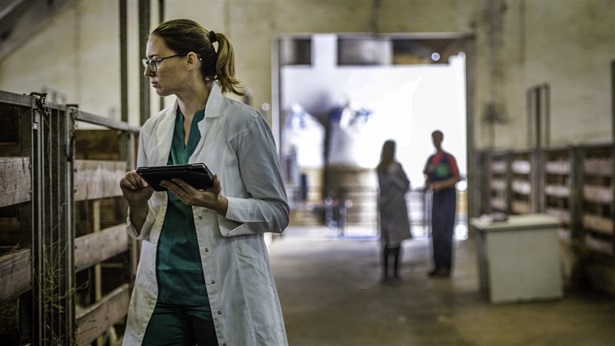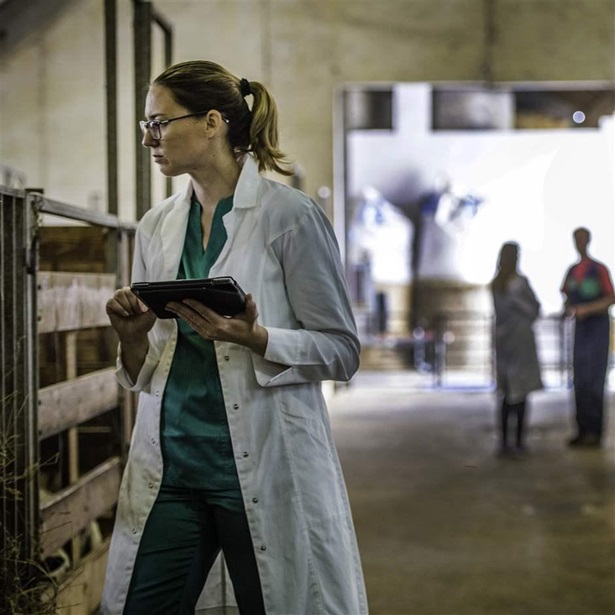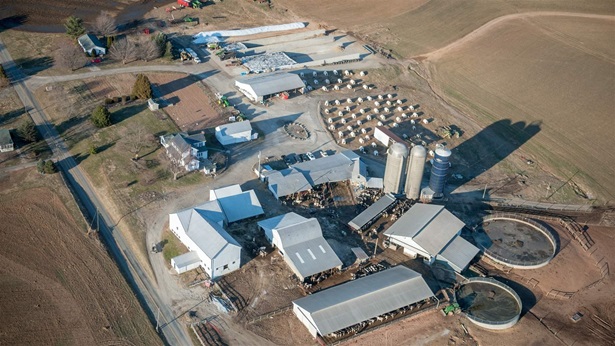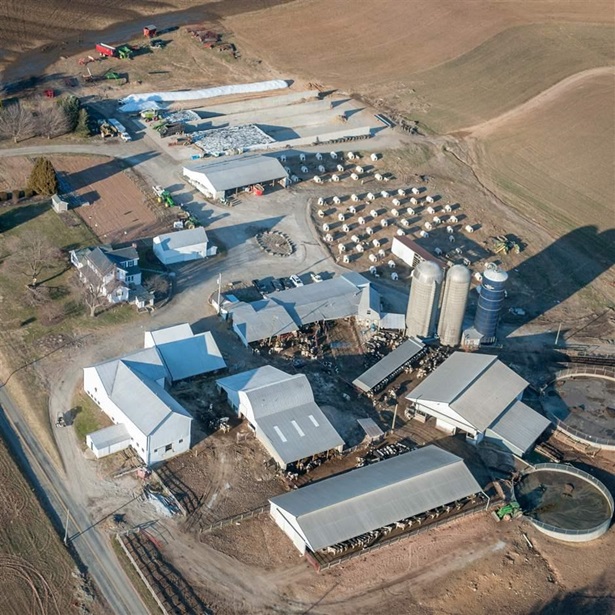Reports Offer Valuable Information on Antibiotic Stewardship in U.S. Agriculture
More frequent USDA surveys and plans to improve FDA data could enhance further insights on use

This fact sheet was updated in October 2019 to reflect the most recent data.
Overview
In May, the U.S. Department of Agriculture released new data on the use of antibiotics in U.S. operations that raise swine or feedlot cattle—information that provides crucial insights into antibiotic stewardship practices, helps identify areas for improvement, and guides policy efforts to combat antibiotic resistance.
Since 1990,1 the USDA has collected nationally representative survey data on animal health, productivity, and management practices—including information related to antibiotic stewardship. These surveys were undertaken only every five to seven years due to resource constraints, with some collecting varying amounts of information on antibiotic stewardship. To address the growing threat of antibiotic resistance, the USDA committed, as part of the 2015 Antimicrobial Resistance Action Plan, to collecting data every two years on antibiotic use and stewardship practices on operations that raise swine and feedlot cattle.2
The May data releases are the first of these new biennial reports and provide information on antibiotic use and stewardship practices during 2016, including which antibiotics operations used, how they administered the drugs, what diseases or conditions were addressed, and how these antibiotic-use decisions were made. This information is extremely valuable for informing policy actions. However, expanding the surveys to collect other key data— such as the dosage and duration of each antibiotic use and whether treatments were successful or had to be repeated—would help to better guide stewardship efforts in U.S. agriculture.
Stewardship trends revealed in the reports
The data show that in 2016, antibiotic use was widespread in cattle and swine operations—in use at more than 95 percent of swine and 85 percent of cattle operations.3 The findings also suggest that many operations may have used numerous antibiotics concurrently, including a substantial number administering three or more of these drugs at once.4
In addition to the widespread use of antibiotics in feed, the reports highlight the use of injectable antibiotics in more than three-quarters of cattle and swine operations.5 Moreover, several operations gave injectable antibiotics to groups of animals to prevent or control infections instead of treating only individual animals that were sick.6 These findings emphasize the critical need to bring these drugs, all of which are also important for human medicine, under veterinary oversight to ensure their judicious use in animal agriculture.
Growth promotion7 and the management of respiratory diseases were key drivers of antibiotic use for both cattle and swine operations. Other common reasons for use included diarrhea for swine and coccidiosis8 and liver abscesses9 in cattle. It is important to note that liver abscesses are typically caused by feeding a diet too rich in grain and are therefore not a judicious use10 of medically important antibiotics.
Among the antibiotics most commonly used in both species were tetracyclines, a class that the World Health Organization (WHO) considers highly important for human medicine.11 Macrolides, which the WHO ranks as “highest-priority critically important,” were also widely used.12
The reports also offer important insights into stewardship practices, including how farmers made antibiotic-use decisions, how and from whom they obtained the drugs, what use records they maintained, how they accessed veterinary care, and how often veterinarians visited the operations. Notably, 96 percent of swine operations reported a formalized veterinarian-client-patient relationship, as did 85 percent of feedlot operations.13
Data gaps remain
The USDA reports complement data on antibiotic sales published each year by the Food and Drug Administration—the only nationally comprehensive, annual data source to gauge antibiotic consumption trends in U.S. animal agriculture. In 2017, for the first time, FDA data showed that sales of medically important antibiotics had dropped more than 30 percent from the previous year.14 The data, however, do not reveal what drove the decrease. Because the USDA’s surveys, until now, were not collected frequently enough to provide meaningful insights into changing consumption trends, it has been difficult to correlate decreasing antibiotic sales with specific changes in stewardship practices.
The USDA’s two recent reports show that antibiotic use in feed was common on operations raising swine and cattle. In swine operations, the commonly used antibiotics chlortetracycline and tylosin—which is a highest-priority critically important macrolide—were used on average for some two and five weeks, respectively.15 In contrast, the reports provide little information on how long individual antibiotics were used in feedlot cattle. Data from previous USDA surveys of large U.S. feedlots suggest that tylosin may be used in cattle feed for five or more consecutive months.16 On the other hand, the data also suggest that medically important chlortetracycline may be used for less than two weeks on average.17
The only available data on duration of use for feedlot cattle are 10 years old. Practices may have changed, so there is an urgent need for USDA to report this metric.
The currently available data also do not say at what dosage the antibiotics were administered and whether they were used to prevent, control, or treat a disease. Similarly, the data do not indicate how effective the antibiotics were. Data from the USDA’s 2011 feedlot survey suggest that sometimes treatments for respiratory diseases failed and that animals needed to be retreated.18 But newer data are needed to better understand this issue, and the USDA should start consistently collecting this information as part of its surveys.
The USDA reports also do not provide insights into the characteristics of the swine and cattle operations that reported no antibiotic use. Information about practices there could provide valuable clues for antibiotic stewardship. For instance, some of these operations may have successfully refined a set of management processes, vaccines, or other antibiotic alternatives that keep animals healthy with little need for antibiotics.
How to move forward
Over time, the biennial USDA surveys will provide important data on antibiotic stewardship practices. As the agency prepares for upcoming surveys, it should explore new ways to incentivize farmers to participate in them. It should also expand data collection efforts to address some of the remaining data gaps and provide additional insights into which stewardship practices are most effective at protecting animal health. Additional funding will likely be needed to fully support these studies and other research outlined in the USDA’s
Antimicrobial Resistance Action Plan,19 as well as the USDA Animal and Plant Health Inspection Service’s 2015 Proposed Initiatives Agenda.20 Congress should prioritize investments in data collection and reporting, which should include expanding the veterinary laboratory networks to support improved understanding of changes in antibiotic resistance patterns over time.
Meanwhile, several FDA proposals outlined in the agency’s recent five-year plan could also help close data gaps and complement existing information. For instance, FDA has also sponsored pilot projects to assess on-farm antibiotic use. When published, these could provide a better understanding of antibiotic-use practices on farms, including data on dosage and duration that have so far remained scarce.21
In addition, FDA has committed to continue working with the USDA and other stakeholders to enable additional insights from existing data on antibiotic consumption trends. For example, FDA proposed22 a standardized method in 2017 for adjusting sales estimates by the size of the animal populations at risk for needing antibiotics. Known as the biomass adjustment, it can help explain trends and fluctuations in antibiotic use, which may be driven by changes in animal populations such as animal life span, or species or breed composition. While the biomass adjustment doesn’t replace antibiotic use data, its finalization would be an important step toward making the currently available sales data more useful.
The USDA’s recent reports on antibiotic stewardship practices in swine and feedlot cattle provide valuable insights but leave important stewardship questions unanswered. Consistent data collection—including the expansion and timely repetition of existing efforts—in combination with FDA’s attempts to obtain better insights into antibiotic use patterns will help guide the push to foster stewardship, develop antibiotic alternatives, and promote the best management practices. This, in turn, will reduce the need for antibiotics and strengthen initiatives to combat resistant bacteria.
Endnotes
- U.S. Department of Agriculture, “National Animal Health Monitoring System: National Studies of U.S. Livestock and Poultry—Collecting Vital Information on Animal Health” (2010), https://www.aphis.usda.gov/animal_health/nahms/downloads/NAHMS_brochure.pdf.
- U.S. Department of Agriculture, “Antimicrobial Use and Stewardship on U.S. Feedlots, 2017” (2019), https://www.aphis.usda.gov/animal_health/nahms/amr/downloads/amu-feedlots.pdf; U.S. Department of Agriculture, “Antimicrobial Use and Stewardship on U.S. Swine Operations, 2017” (2019), https://www.aphis.usda.gov/animal_health/nahms/amr/downloads/amuswine_redocb_cb3edits.pdf.
- U.S. Department of Agriculture, “Antimicrobial Use and Stewardship on U.S. Feedlots, 2017”; U.S. Department of Agriculture, “Antimicrobial Use and Stewardship on U.S. Swine Operations, 2017.”
- These data are not sufficiently broken out for all species and age groups to fully characterize this issue.
- U.S. Department of Agriculture, “Antimicrobial Use and Stewardship on U.S. Feedlots, 2017”; U.S. Department of Agriculture, “Antimicrobial Use and Stewardship on U.S. Swine Operations, 2017.” .
- U.S. Department of Agriculture, “Antimicrobial Use and Stewardship on U.S. Feedlots, 2017.”
- On Jan. 1, 2017, the use of medically important antibiotics for growth promotion became illegal in the U.S. Using nonmedically important antibiotics such as ionophores for this purpose remains legal, but not all of the data were sufficiently broken out to clarify uses.
- P.D. Constable, “Coccidiosis of Cattle,” Merck Veterinary Manual, https://www.merckvetmanual.com/digestive-system/coccidiosis/coccidiosis-of-cattle.
- The Pew Charitable Trusts, “Judicious Animal Antibiotic Use Requires Drug Label Refinements,” Oct. 4, 2016, https://www.pewtrusts.org/en/research-and-analysis/issue-briefs/2016/10/judicious-animal-antibiotic-use-requires-drug-label-refinements.
- T.G. Nagaraja and K.F. Lechtenberg, “Liver Abscesses in Feedlot Cattle,” Veterinary Clinics of North America: Food Animal Practice 23, no. 2 (2007): 351-69, https://www.ncbi.nlm.nih.gov/pubmed/17606156; T.G. Nagaraja and M.M. Chengappa, “Liver Abscesses in Feedlot Cattle: A Review,” Journal of Animal Science 76, no. 1 (1998): 287-98, https://www.ncbi.nlm.nih.gov/pubmed/9464910.
- World Health Organization, “Critically Important Antimicrobials for Human Medicine, 6th Revision” (2019), https://apps.who.int/iris/bitstream/handle/10665/312266/9789241515528-eng.pdf?ua=1.
- Ibid.
- U.S. Department of Agriculture, “Antimicrobial Use and Stewardship on U.S. Feedlots, 2017”; U.S. Department of Agriculture, “Antimicrobial Use and Stewardship on U.S. Swine Operations, 2017.”
- Food and Drug Administration, “2017 Summary Report on Antimicrobials Sold or Distributed for Use in Food-Producing Animals” (2018), https://www.fda.gov/media/119332/download.
- U.S. Department of Agriculture, “Antimicrobial Use and Stewardship on U.S. Swine Operations, 2017.”
- U.S. Department of Agriculture, “Feedlot 2011 Part IV: Health and Health Management on U.S. Feedlots With a Capacity of 1,000 or More Head” (2013), https://www.aphis.usda.gov/animal_health/nahms/feedlot/downloads/feedlot2011/Feed11_dr_PartIV.pdf.
- Ibid.
- Ibid.
- U.S. Department of Agriculture, “Antimicrobial Resistance Action Plan” (2014), https://www.usda.gov/sites/default/files/documents/usda-antimicrobial-resistance-action-plan.pdf.
- U.S. Department of Agriculture, Animal and Plant Health Inspection Service, “Proposed Initiatives From the USDA Antimicrobial Resistance Action Plan” (2015), https://www.aphis.usda.gov/animal_health/nahms/amr/downloads/ProposedInitiatives.pdf.
- R.S. Singer and L. Porter, “Estimates of On-Farm Antimicrobial Usage in Broiler Chicken and Turkey Production in the United States, 2013-2017” (Mindwalk Consulting Group, 2019), http://www.uspoultry.org/poultry-antimicrobial-use-report/docs/Poultry_On-Farm_Antimicrobial_Use_Report_2013-2017.pdf.
- The Pew Charitable Trusts, “FDA Proposal Would Make Animal Antibiotic Sales Data More Useful,” Sept. 13, 2018, https://www.pewtrusts.org/en/research-and-analysis/articles/2018/09/13/fda-proposal-would-make-animal-antibiotic-sales-data-more-useful.


Veterinarians Should Oversee All Antibiotic Use in Food Animals


How Family Farmers Raise Animals With Few Antibiotics


FDA Proposal Would Support Fight Against Antibiotic-Resistant Bacteria










